merantau
Senior Member
TAMBORA – THE MOUNTAIN THAT BLEW ITS TOP
I’d been travelling east of Bali for less than two weeks but a lot had happened. At 6.00 am on a Monday morning, I’d nosed out into the traffic on Jalan Padma, Legian, Bali and headed east to catch the ferry to Lombok, a little wary but, nevertheless, eager to immerse myself in whatever might come my way in the weeks ahead. Now I was on Sumbawa, two islands east of Bali, and I’d just had a minor accident. But the bike and I had come away virtually unscathed, so ... it was time to move on!
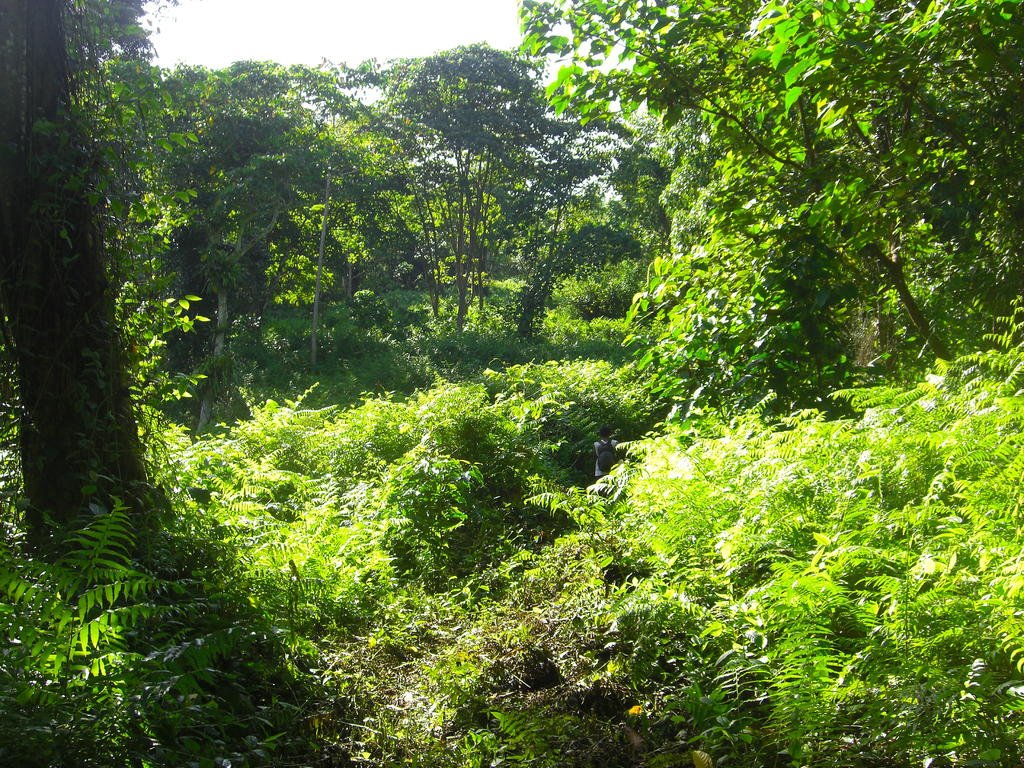
I crawled along, determined to stay upright. A little while later a rider breasted a low hill and weaved his way towards me waving as he drew alongside. Then I spotted him in the rear vision mirror as he braked and did a U-turn.
He pulled up alongside and yelled out, “Tambora?” I stopped and we began to chat in Indonesian. The young bloke’s name was Haris and he had been up Tambora a few times. He told me of the organisation – K-PATA – set up to co-ordinate ascents. Haris was a mine of information. He looked fit and capable and answered all my questions in a straight forward manner. He’d been on his way to Dompu, ‘But that can wait,’ he said. He’d much rather be my guide, so we struck a deal, shook hands and headed off for Calabai, the last village where supplies could be purchased.
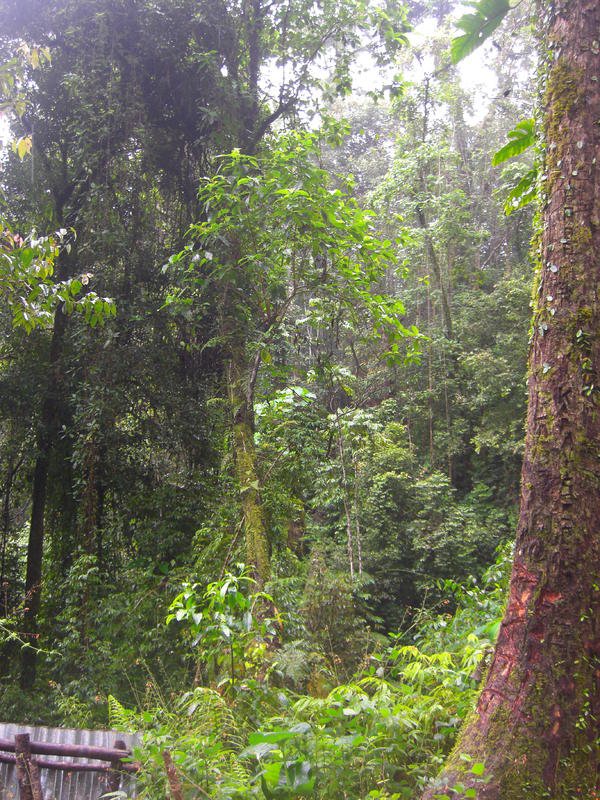
Within an hour we reached the village – a couple of small government agencies and an assortment of shops and rude dwellings strung out along a narrow, pock-marked main street. Chickens roamed freely and the occasional dog nosed through the garbage in competition with a herd of wild-eyed goats. Not much happened in Calabai. Not even the arrival of a foreigner in this far-off place could stir the locals as they slumbered through the afternoon heat. In a store crammed with foodstuffs and farmers’ supplies, we stocked up with instant noodles, bananas, eggs, sweet buns, and bottled water. Three pretty teenagers busied themselves assembling our purchases. The owner, an elderly matron, was pleased to fill this unexpected order on a slow afternoon. Laden with plastic bags we headed for the bikes and after securing our loads we set sail.
The track to Pancasila, passed by cultivated fields and pastures where cattle grazed contentedly. The road provided a stark counterpoint to this bucolic scene. A nightmare of mud and washaways, punctuated with deeply rutted sections, it rose steadily, winding its way around Tambora’s lower contours. Haris led the way unerringly. I followed in his wake. An hour beyond Calabai and we were there. We crossed the football field, where a mob of bare foot boys played a spirited game, and stopped in front of a sign board announcing that this was the headquarters of K-PATA – Kelompok Pencinta Alam Tambora – the Nature Lovers’ Group of Tambora.
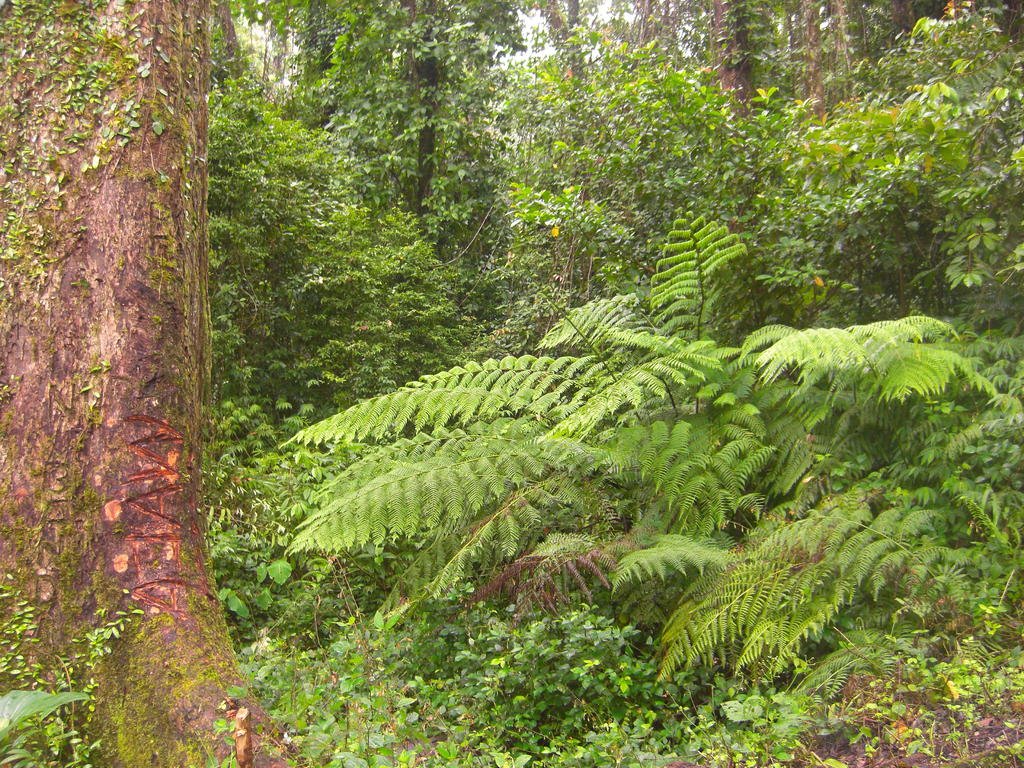
We were met by the ranger, Saiful, who invited us inside. Ordering his daughter Dinda to prepare coffee, he ushered us into a small room where we sat on mats and began to talk. Saiful explained his role as custodian of the Park. He produced the visitors’ book and a pamphlet about the mountain and its famous eruption. Tambora saw few visitors. On average about 30 people a year made the climb - mostly Indonesian students from university adventure clubs. Saiful explained the dangers of the trek and insisted I take two guides – common sense really as, if anything untoward happened, there was no phone coverage and the injured person would have to be left while the other went for help. Seldom visited, the track was heavily overgrown. The ascent, let alone any rescue mission, was sure to be a challenge.
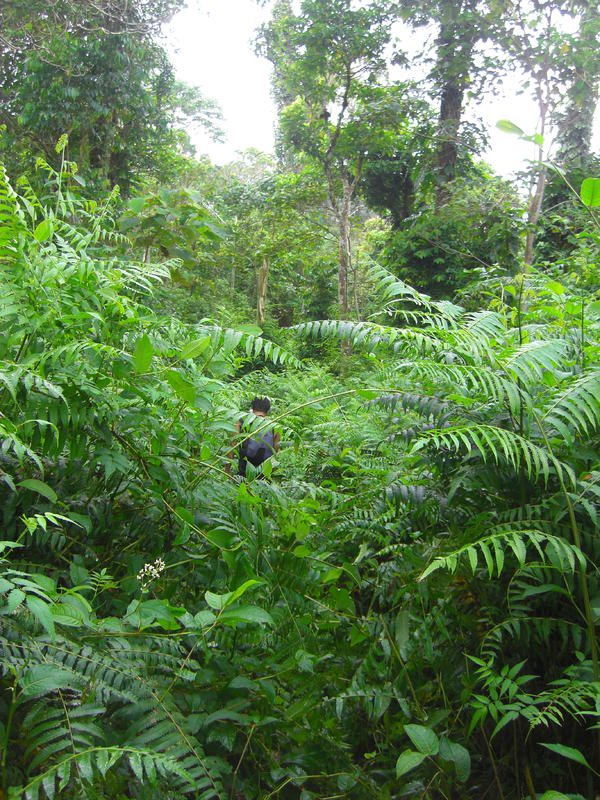
And so, I was introduced to Farouk, a married man in his 30s. Wiry and compact, he’d made the trip many times. He looked at me warily wondering if, at age 60, I’d be up for the journey. I assured him that I’d be fine and that I’d be carrying my own gear too. We agreed to set out at 7.00 next morning. The plan was to reach ‘Post 3’ in the afternoon. There we would rest, eat and sleep before the final push to the summit which would begin at 1.00 am and hopefully terminate at the crater rim at dawn. A few hours up top and then it was back down with the expectation of reaching K-PATA headquarters by nightfall.
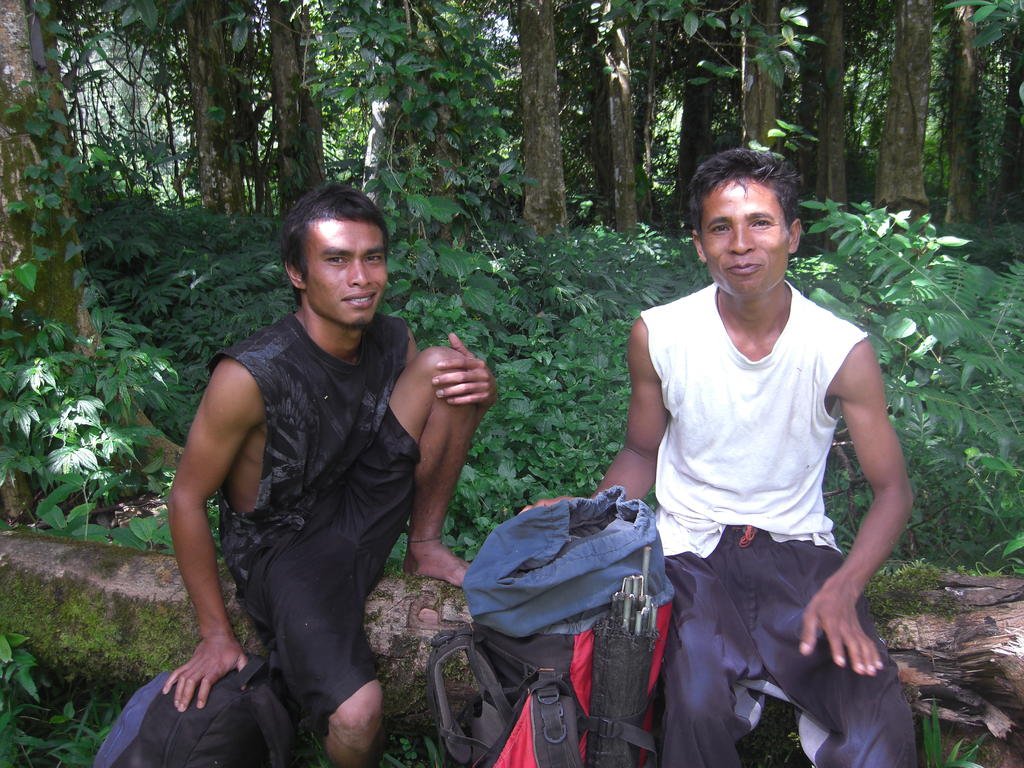
We shook hands and, after a good meal of rice, cassava leaves, spinach and salted fish, Farouk and Haris departed. I headed off for a shower and bed. My wounded knee, from the bike accident, had stiffened up a bit but the cut was clean with no redness – the tell-tale sign of infection - so I’d get by.
Sleep came easily that night; it had been a long day. I was awake with the village roosters. Coffee and pisang goreng, (banana fritters), were on the go and, before long, the four of us, Haris and Farouk having arrived at 6.30 am, were being served by Dinda and her mother. All was in readiness and refreshed with full bellies, and the stimulation provided by glasses of thick, black, coffee, we made our farewells and stepped out onto the track beside the house.
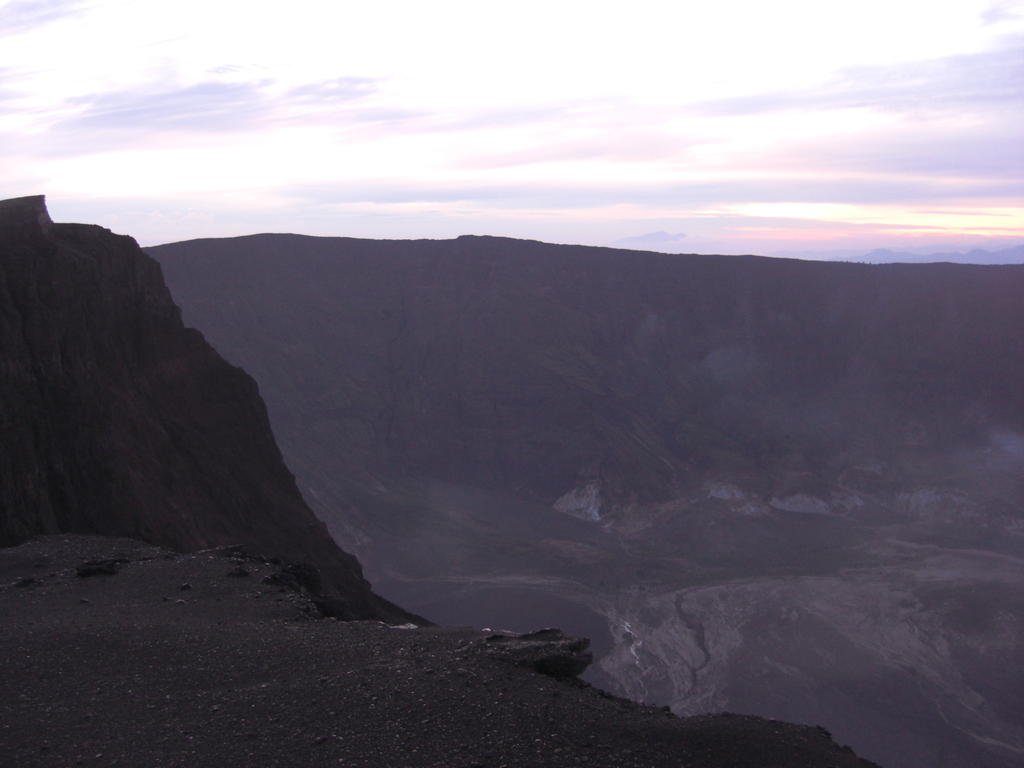
It felt good to get underway. The air was chill and the grass wet with dew. The track rose gently, passing by a coffee plantation, the trees laden with berries. After thirty minutes we came to a bamboo gate which announced the Park entrance. We slipped past and began to climb more steeply. This was indeed a footpath only. Narrow and ill-defined it was totally overgrown with trailing creepers and bracken. It was not long before the parangs (machetes) came out and Farouk and Haris began slashing vigorously at the dew-laden vegetation. We were soon saturated. The greenery was like a thick curtain, trying to swallow us up. Our choices were stark - we either resist or succumb to our verdant host. We pressed on.
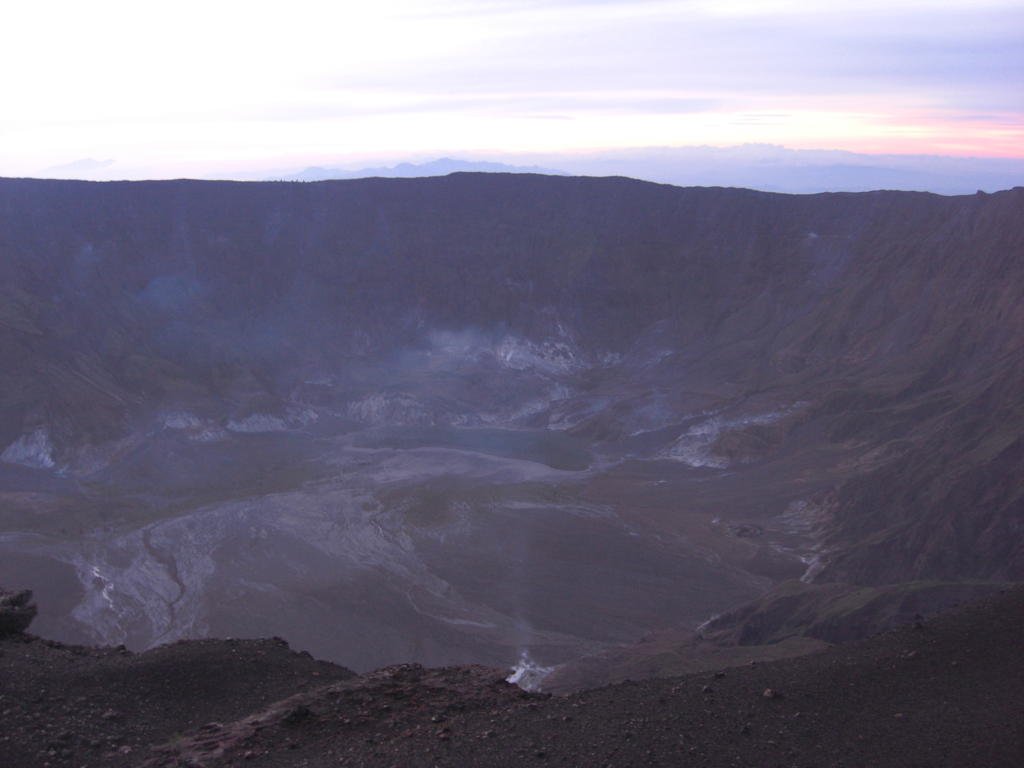
We were now deep in primary jungle. It had become increasingly difficult for light to penetrate the canopy overhead. Forest giants, home to a riot of climbing vines, with lush, bushy epiphytes clinging to their trunks, reached skywards, their crowns melding into the curtain of greenery which blocked out the sky. An occasional opening, revealed a dense blanket of rainclouds. It wasn’t long before we heard thunder rolling over the mountain. We trudged on wondering how long it would be before the storm broke. The peals of thunder came closer splitting the air with their reverberations.
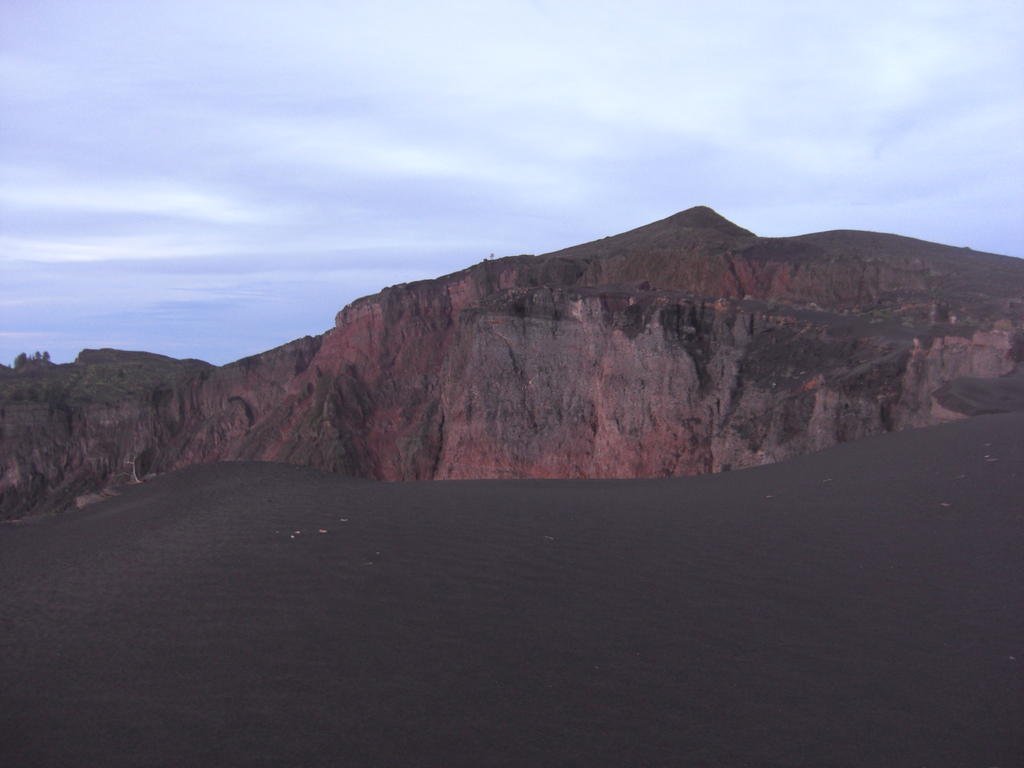
The first droplets to reach us were refreshing; we had been straining our way up a steep incline fit for the labours of Sisyphus. But within minutes we were drenched as water streamed from every tendril. And so it continued for three hours as we hacked our way up the forested slopes. At each rest point we’d remove our shoes to get rid of the leeches. Haris used his parang to make sure they would not return for second helpings! It was pointless changing into dry gear – we didn’t have any! I later discovered that even my passport, which I’d placed in a zip-lock bag inside my money belt, did not escape the deluge; it remains water damaged to this day.
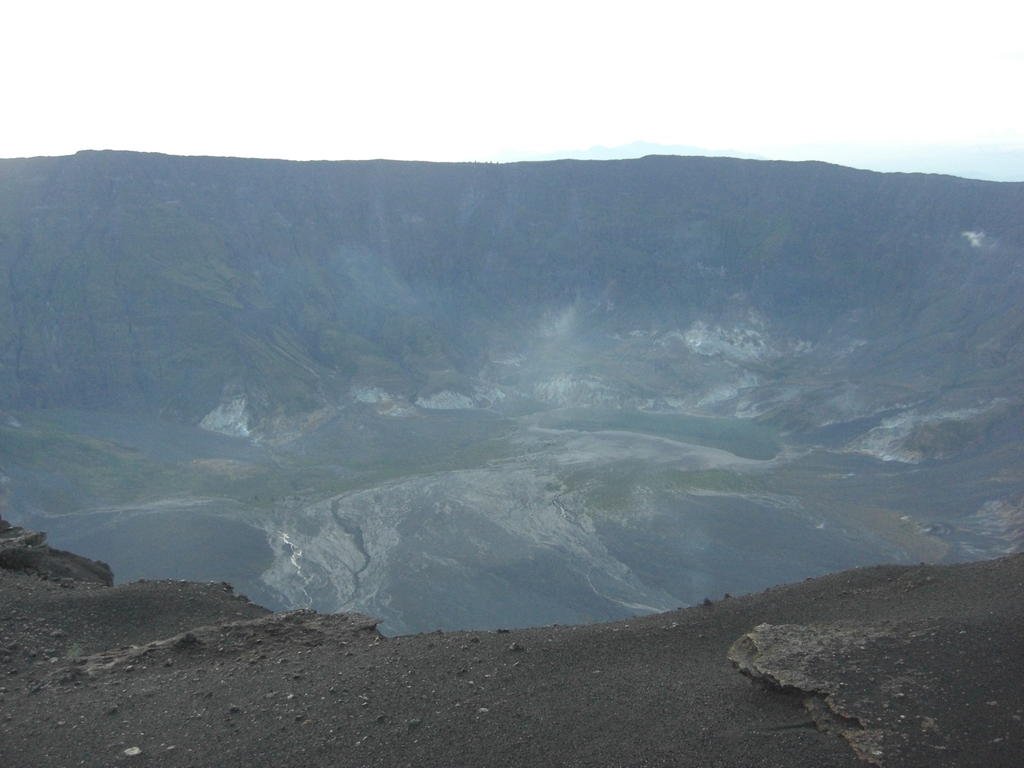
At 3.00 pm, eight hours after setting out, we staggered into Post 3, a rude shelter fashioned out of bush timber and roofed with corrugated iron that some hardy souls had dragged up from below. Built on stumps and set in a tiny clearing surrounded by giant ferns, it was as welcome as any Hilton. By now the rain had ceased. Farouk found some dry wood beneath the shelter and lit a fire. I rigged up a line to dry clothes. In the steamy afternoon humidity this was more a gesture of hope than of expectation.
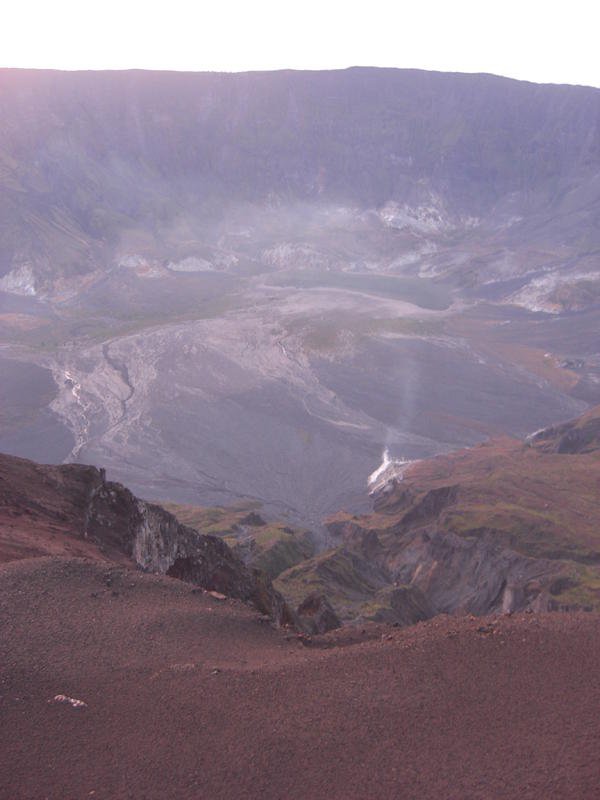 The exertions of the day had left us ravenous and we attacked our food with relish. Rice, noodles, eggs and sweet buns were washed down with coffee. Haris and Farouk luxuriated in their first smoke for a few hours. We stoked the fire, producing a cheery blaze, and tried to dry some clothes. We chatted about our plan for the night ascent. Farouk and Haris were agreed. We should rise at midnight, eat a hot meal, drink plenty of coffee and leave before 1.00. I asked about the going and was dismayed to learn we still had some work to do before we got above the tree line. What’s more we were yet to reach the region of the dreaded jelantik, or stinging nettle. Brushing against this nasty was, according to Haris, like being seared with a welder’s torch. To make our way through it we would have to shinny up two fallen forest giants. Each lay against the mountainside at a 30 degree angle and, on either side, the jelantik lay waiting to enclose a fallen climber in its poisonous embrace. The thought of this happening under torchlight at 3.00 am was, needless to say, sobering.
The exertions of the day had left us ravenous and we attacked our food with relish. Rice, noodles, eggs and sweet buns were washed down with coffee. Haris and Farouk luxuriated in their first smoke for a few hours. We stoked the fire, producing a cheery blaze, and tried to dry some clothes. We chatted about our plan for the night ascent. Farouk and Haris were agreed. We should rise at midnight, eat a hot meal, drink plenty of coffee and leave before 1.00. I asked about the going and was dismayed to learn we still had some work to do before we got above the tree line. What’s more we were yet to reach the region of the dreaded jelantik, or stinging nettle. Brushing against this nasty was, according to Haris, like being seared with a welder’s torch. To make our way through it we would have to shinny up two fallen forest giants. Each lay against the mountainside at a 30 degree angle and, on either side, the jelantik lay waiting to enclose a fallen climber in its poisonous embrace. The thought of this happening under torchlight at 3.00 am was, needless to say, sobering.
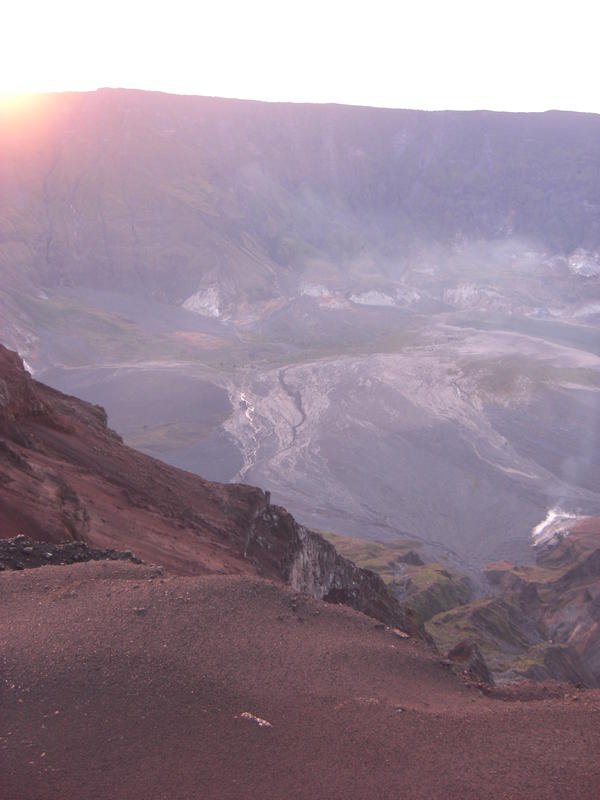
It was time to rest. We lay down on the teak boards and tried to get comfortable. Damp clothes, hard boards, a coolish breeze and, just on dusk, the arrival of a squadron of mosquitoes, conspired to keep us awake. Furthermore, every time I made a move to seek some comfort, I’d cramp in the quadriceps, or hamstring or calf – at times it seemed like all three at once! It’s very difficult to sleep and massage your screaming muscles at the same time.
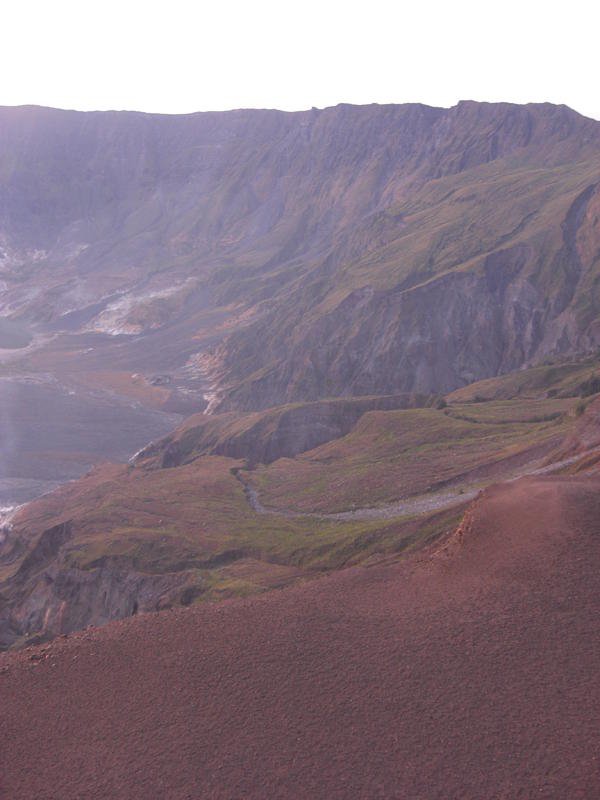
Darkness closed over us with the rapidity of a stage curtain and we were left to contemplate the night sounds of the ever-present jungle. Far off we heard the faint rumble of thunder; each of us secretly hoped it was not coming our way. Close by, a burung hantu, which literally means ghost bird, began to hoot eerily. The undergrowth rustled with the passage of a large beast – maybe a wild pig or a small deer. Sleep would not come and I began to worry about the hours ahead. Would this enterprise end in failure or, even worse, end disastrously with one of us injured precipitating an emergency rescue? Thankfully, my wounded knee had not troubled me so far. Or, by some conspiracy of the clouds, would we be denied a view of Tambora’s awesome crater by the onset of more atrocious weather? I pushed the thoughts from my mind and entered the twilight zone of dozeland – unsure if I was dreaming or thinking, vaguely aware of my physical discomfort, but unwilling, to move lest I jerk myself back into wakefulness.
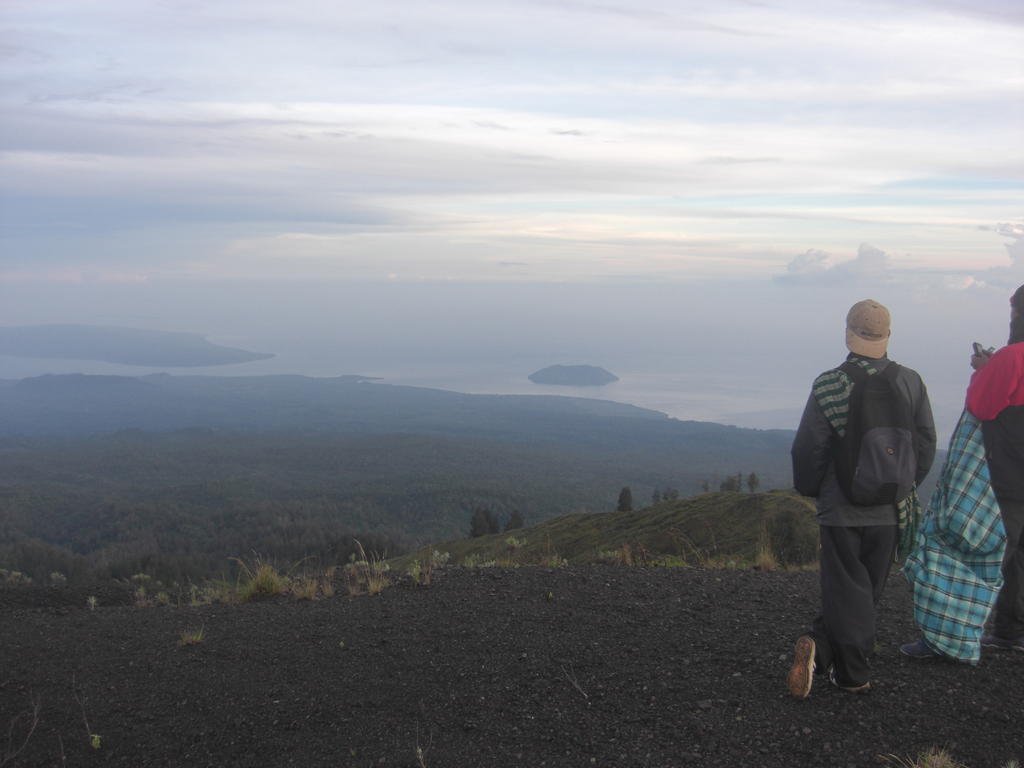
In this way I cobbled together an hour’s rest before my mobile’s alarm came to life with The Eagles crooning, ‘Welcome to the Hotel California’. I stirred, moving gingerly so as to not bring on cramp. The breeze had abated but the air was cold. Haris blew on the embers and soon had a blaze going, its halo a red glow pushing against the black night. Our clothes – and most importantly – shoes and socks had dried, so, at least we would be comfortable for a while. Plenty of warm food and hot coffee primed us, and at 1.00 am precisely we left camp and struck out into the green curtain ahead.
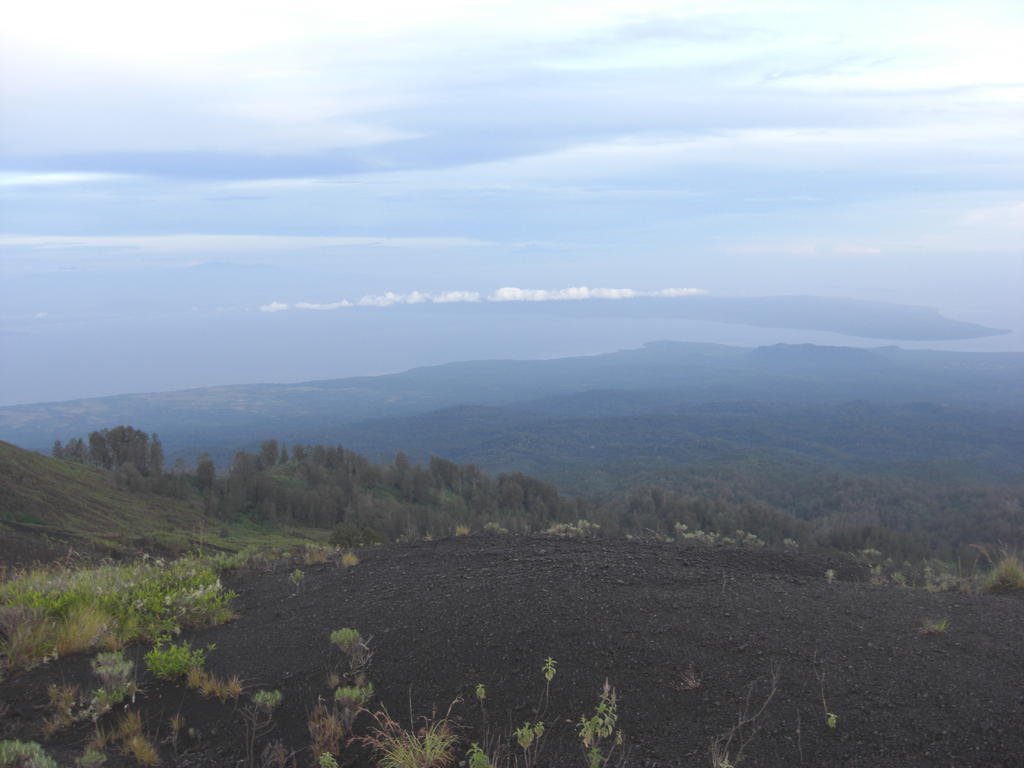
The narrow trail wound steadily on. We climbed under and over fallen trees eventually reaching the first fallen giant that would carry us safely above the jelantik. The tree was too slippery to walk along. Perhaps 40 meters long we could just straddle it and, using our hands, drag ourselves along. On either side, a metre below, the jelantik lay waiting. My head torch lighting the way, I inched myself forward after the others. Its silvery beam illuminating the seemingly endless wall of greenery, I wondered aloud: “When will this forest end?” The answer came back from Farouk, “One more hour.” Could I hang on until we reached the easier going?
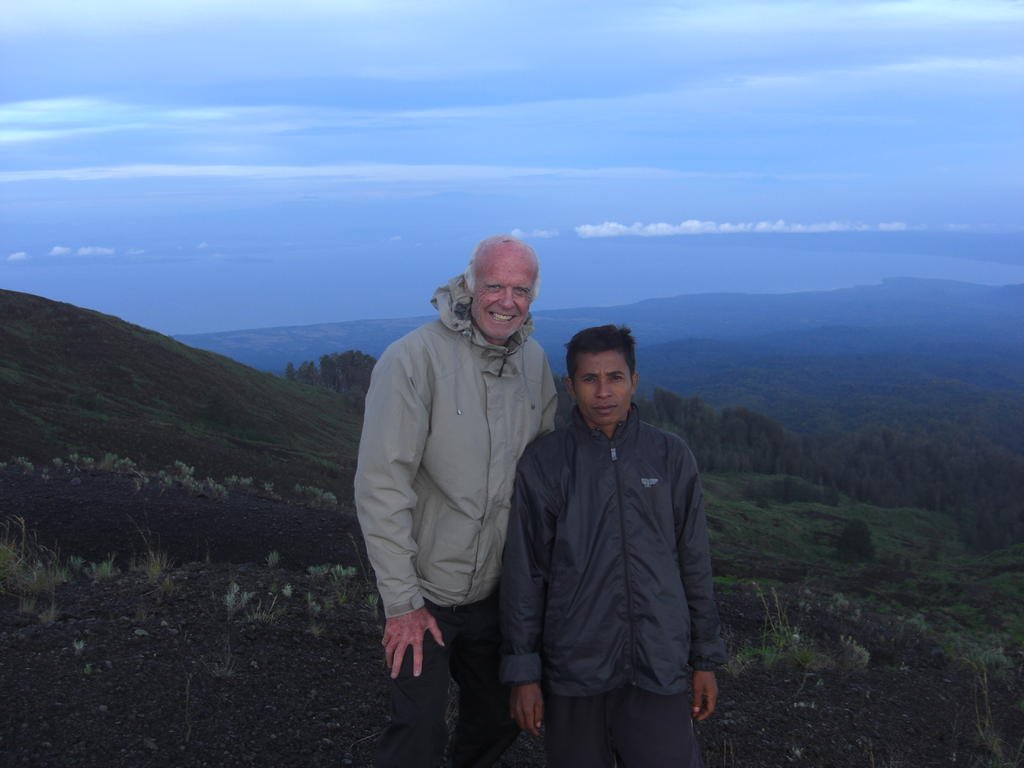
True to his word, shortly after negotiating a second fallen monster, we found ourselves in flatter, more open country. Trees were smaller, thinner – a different species altogether – and instead of alang grass and trailing creepers, we were pushing our way through tussocky grass and could feel scoria, not slippery earth, beneath our feet – at last some easier going! The lightening sky brought promise of a soon-to-come rendezvous with the summit. Our hopes rose. We quickened our pace, eager to take in the long-anticipated vista. The open sky above was clear. The firmament blinked and twinkled a greeting to the first rays of dawn – we were assured of clear, uninterrupted views all the way to Lombok!
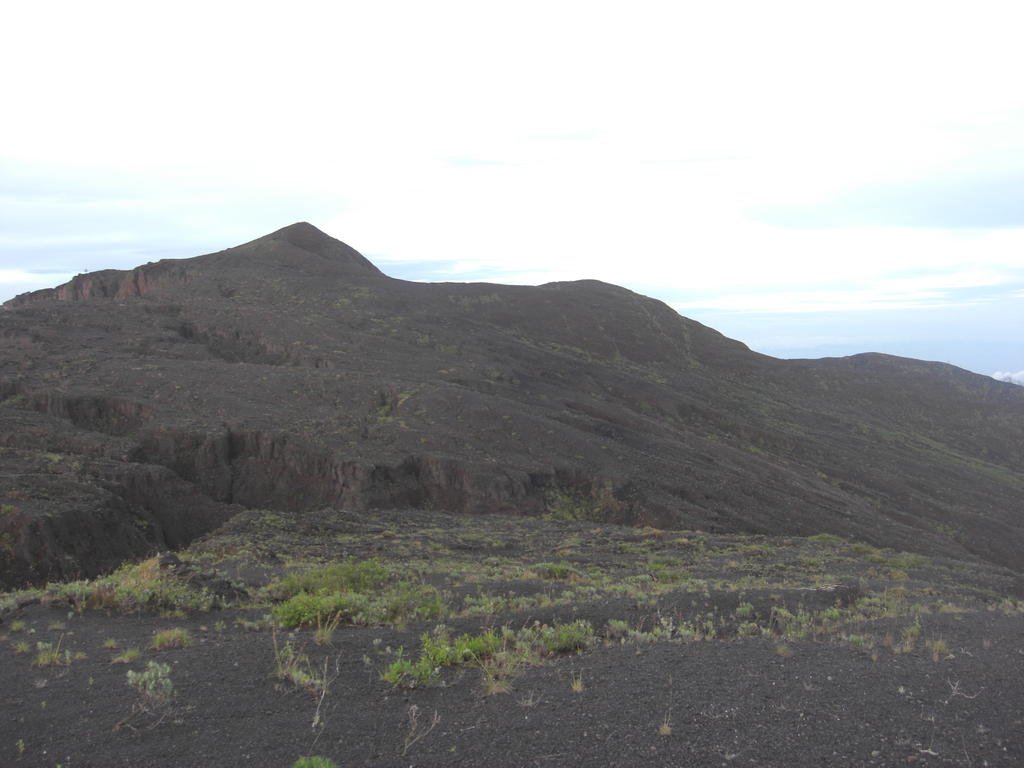
The last few hundred metres were a scramble over a moonlike surface of, scoria and small rocks. With perfect timing we reached the crater’s edge. In the dim light we could sense we were standing, looking down into an awesome chamber. Gradually the sky lightened and our eyes feasted on a stupendous sight – Tambora’s crater bathed in the sun’s first rays. Seven kilometres wide, 21 kilometres in circumference, 350 metres deep, its sombre presence defied description. It was simply – THERE! - the result of the most cataclysmic event in modern history. No words were needed to describe our feelings. We smiled and embraced; my steadfast companions lit up a smoke. Below us the mountain fell away to the coast, beyond which lay the islet of Satonda with its salt water lake, created courtesy of the tsunami which followed the explosion – the explosion ‘that shook up the world.’ Far away to the west, waves caressed the fractured, indented northern Sumbawa coastline whilst we contemplated the massive power of nature and the inevitability of the trip back down the mountain.
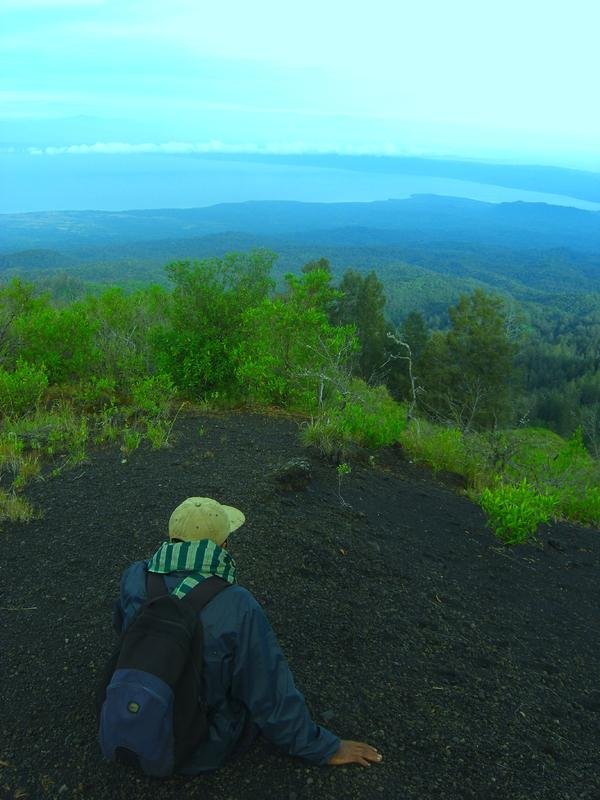
We stayed up top for a couple of hours, resting, eating and congratulating ourselves. Then it was time to go. We stepped away strongly, invigorated by our success. We rested upon reaching the tree line. Starting out again was tough. The descent became a war of attrition – us against the endless forest. I set on a method and stuck to it. Born of sheer bloody-mindedness it was a simple one. Pick out a target 50 metres ahead, achieve it, then, pick out the next one. Hour after hour my achievements built up, but by late afternoon I was really wilting. Resisting the desire to lay down and sleep, I knew we had to keep going for the weather was closing in and darkness was close by, waiting in the wings. Grim-faced we struggled on, each step a victory of sorts.
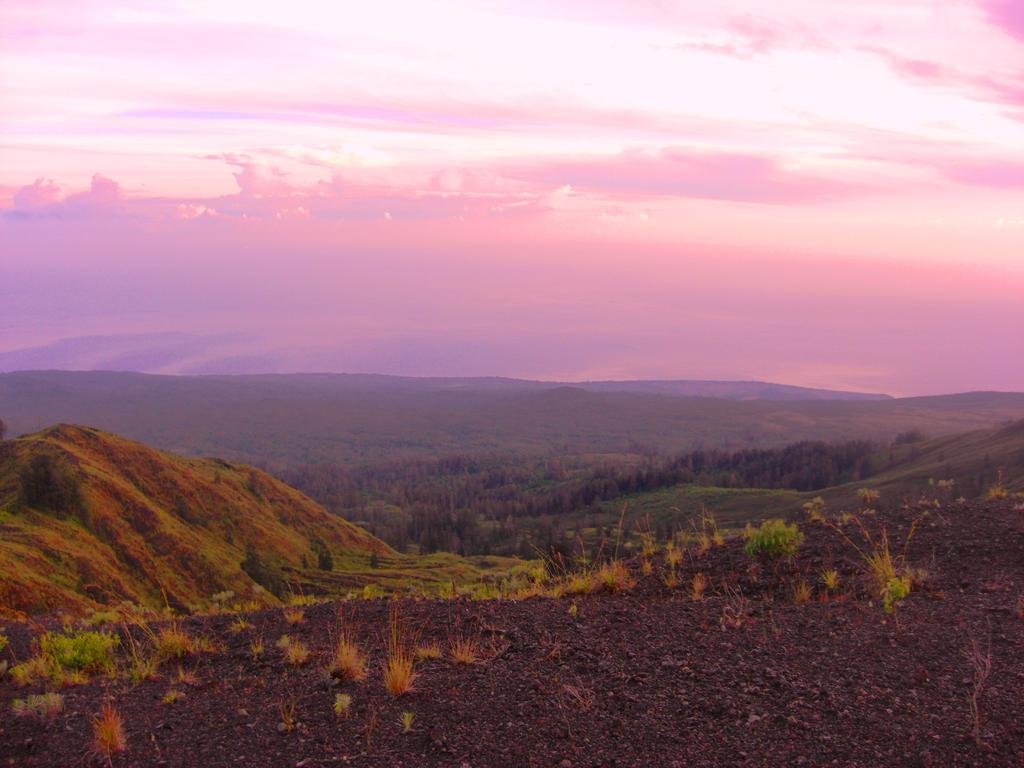
For hours I had resisted the temptation to ask the bleeding obvious: ‘How much further?’ but finally I gave in. The answer came back: ‘Another hour’. I told myself I could hang on. And I did. We reached the bamboo gate and collapsed on the track. Haris phoned his mates to come and pick us up with their motorbikes.
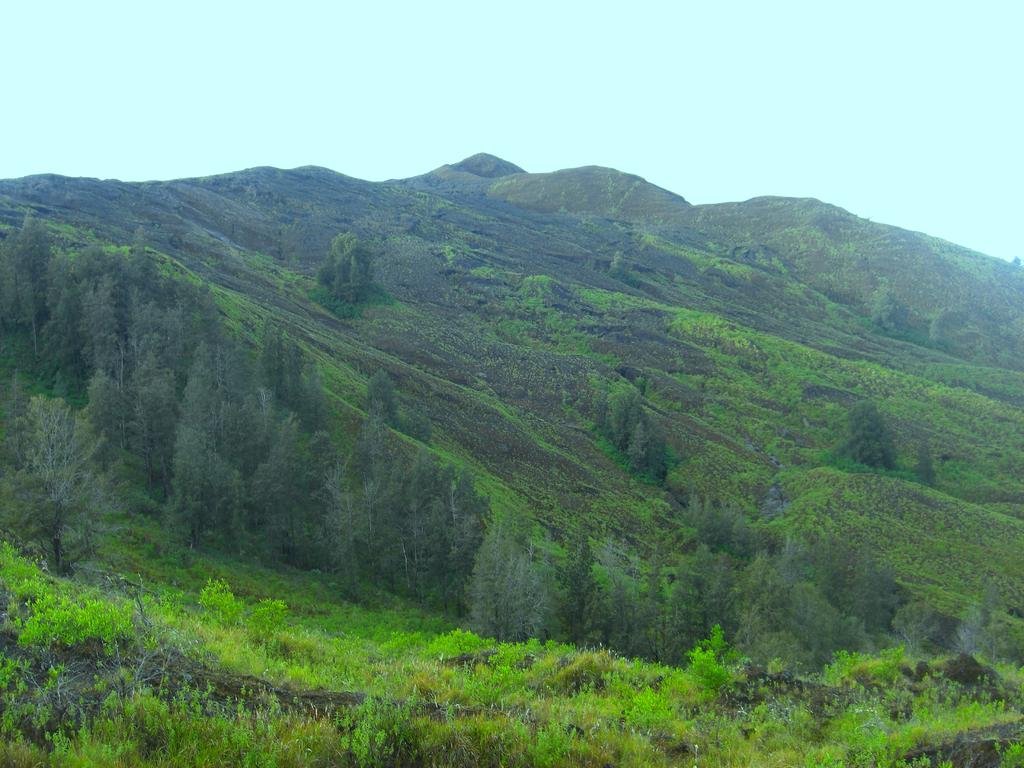
And so we would travel the last few kilometres riding pillion. In 33 hours we’d walked for 24 and had about an hour’s sleep. I figured we’d done our share of walking for a while! Exhausted, but happy, we lay back and waited for the sound of the approaching engines that would close the chapter on our successful slog up the forested slopes of far-off, seldom-seen Tambora.
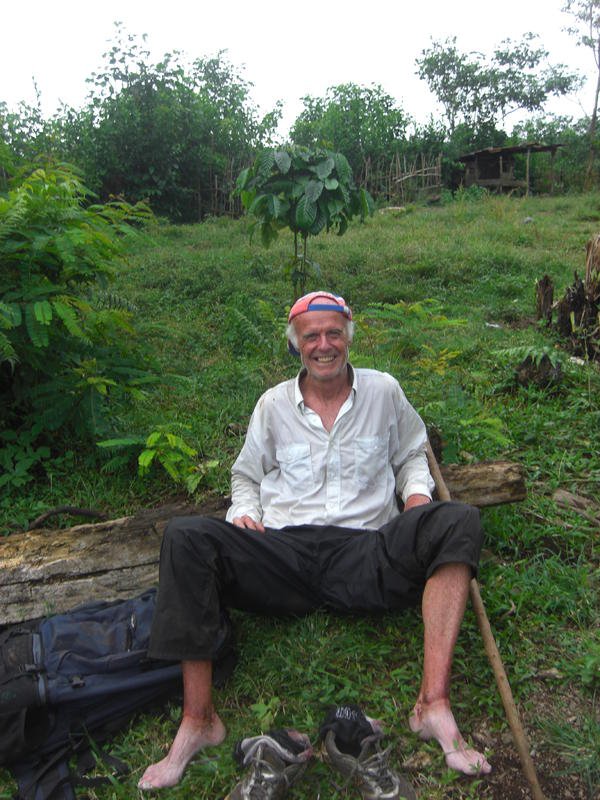
I’d been travelling east of Bali for less than two weeks but a lot had happened. At 6.00 am on a Monday morning, I’d nosed out into the traffic on Jalan Padma, Legian, Bali and headed east to catch the ferry to Lombok, a little wary but, nevertheless, eager to immerse myself in whatever might come my way in the weeks ahead. Now I was on Sumbawa, two islands east of Bali, and I’d just had a minor accident. But the bike and I had come away virtually unscathed, so ... it was time to move on!

I crawled along, determined to stay upright. A little while later a rider breasted a low hill and weaved his way towards me waving as he drew alongside. Then I spotted him in the rear vision mirror as he braked and did a U-turn.
He pulled up alongside and yelled out, “Tambora?” I stopped and we began to chat in Indonesian. The young bloke’s name was Haris and he had been up Tambora a few times. He told me of the organisation – K-PATA – set up to co-ordinate ascents. Haris was a mine of information. He looked fit and capable and answered all my questions in a straight forward manner. He’d been on his way to Dompu, ‘But that can wait,’ he said. He’d much rather be my guide, so we struck a deal, shook hands and headed off for Calabai, the last village where supplies could be purchased.

Within an hour we reached the village – a couple of small government agencies and an assortment of shops and rude dwellings strung out along a narrow, pock-marked main street. Chickens roamed freely and the occasional dog nosed through the garbage in competition with a herd of wild-eyed goats. Not much happened in Calabai. Not even the arrival of a foreigner in this far-off place could stir the locals as they slumbered through the afternoon heat. In a store crammed with foodstuffs and farmers’ supplies, we stocked up with instant noodles, bananas, eggs, sweet buns, and bottled water. Three pretty teenagers busied themselves assembling our purchases. The owner, an elderly matron, was pleased to fill this unexpected order on a slow afternoon. Laden with plastic bags we headed for the bikes and after securing our loads we set sail.
The track to Pancasila, passed by cultivated fields and pastures where cattle grazed contentedly. The road provided a stark counterpoint to this bucolic scene. A nightmare of mud and washaways, punctuated with deeply rutted sections, it rose steadily, winding its way around Tambora’s lower contours. Haris led the way unerringly. I followed in his wake. An hour beyond Calabai and we were there. We crossed the football field, where a mob of bare foot boys played a spirited game, and stopped in front of a sign board announcing that this was the headquarters of K-PATA – Kelompok Pencinta Alam Tambora – the Nature Lovers’ Group of Tambora.

We were met by the ranger, Saiful, who invited us inside. Ordering his daughter Dinda to prepare coffee, he ushered us into a small room where we sat on mats and began to talk. Saiful explained his role as custodian of the Park. He produced the visitors’ book and a pamphlet about the mountain and its famous eruption. Tambora saw few visitors. On average about 30 people a year made the climb - mostly Indonesian students from university adventure clubs. Saiful explained the dangers of the trek and insisted I take two guides – common sense really as, if anything untoward happened, there was no phone coverage and the injured person would have to be left while the other went for help. Seldom visited, the track was heavily overgrown. The ascent, let alone any rescue mission, was sure to be a challenge.

And so, I was introduced to Farouk, a married man in his 30s. Wiry and compact, he’d made the trip many times. He looked at me warily wondering if, at age 60, I’d be up for the journey. I assured him that I’d be fine and that I’d be carrying my own gear too. We agreed to set out at 7.00 next morning. The plan was to reach ‘Post 3’ in the afternoon. There we would rest, eat and sleep before the final push to the summit which would begin at 1.00 am and hopefully terminate at the crater rim at dawn. A few hours up top and then it was back down with the expectation of reaching K-PATA headquarters by nightfall.

We shook hands and, after a good meal of rice, cassava leaves, spinach and salted fish, Farouk and Haris departed. I headed off for a shower and bed. My wounded knee, from the bike accident, had stiffened up a bit but the cut was clean with no redness – the tell-tale sign of infection - so I’d get by.
Sleep came easily that night; it had been a long day. I was awake with the village roosters. Coffee and pisang goreng, (banana fritters), were on the go and, before long, the four of us, Haris and Farouk having arrived at 6.30 am, were being served by Dinda and her mother. All was in readiness and refreshed with full bellies, and the stimulation provided by glasses of thick, black, coffee, we made our farewells and stepped out onto the track beside the house.

It felt good to get underway. The air was chill and the grass wet with dew. The track rose gently, passing by a coffee plantation, the trees laden with berries. After thirty minutes we came to a bamboo gate which announced the Park entrance. We slipped past and began to climb more steeply. This was indeed a footpath only. Narrow and ill-defined it was totally overgrown with trailing creepers and bracken. It was not long before the parangs (machetes) came out and Farouk and Haris began slashing vigorously at the dew-laden vegetation. We were soon saturated. The greenery was like a thick curtain, trying to swallow us up. Our choices were stark - we either resist or succumb to our verdant host. We pressed on.

We were now deep in primary jungle. It had become increasingly difficult for light to penetrate the canopy overhead. Forest giants, home to a riot of climbing vines, with lush, bushy epiphytes clinging to their trunks, reached skywards, their crowns melding into the curtain of greenery which blocked out the sky. An occasional opening, revealed a dense blanket of rainclouds. It wasn’t long before we heard thunder rolling over the mountain. We trudged on wondering how long it would be before the storm broke. The peals of thunder came closer splitting the air with their reverberations.

The first droplets to reach us were refreshing; we had been straining our way up a steep incline fit for the labours of Sisyphus. But within minutes we were drenched as water streamed from every tendril. And so it continued for three hours as we hacked our way up the forested slopes. At each rest point we’d remove our shoes to get rid of the leeches. Haris used his parang to make sure they would not return for second helpings! It was pointless changing into dry gear – we didn’t have any! I later discovered that even my passport, which I’d placed in a zip-lock bag inside my money belt, did not escape the deluge; it remains water damaged to this day.

At 3.00 pm, eight hours after setting out, we staggered into Post 3, a rude shelter fashioned out of bush timber and roofed with corrugated iron that some hardy souls had dragged up from below. Built on stumps and set in a tiny clearing surrounded by giant ferns, it was as welcome as any Hilton. By now the rain had ceased. Farouk found some dry wood beneath the shelter and lit a fire. I rigged up a line to dry clothes. In the steamy afternoon humidity this was more a gesture of hope than of expectation.
 The exertions of the day had left us ravenous and we attacked our food with relish. Rice, noodles, eggs and sweet buns were washed down with coffee. Haris and Farouk luxuriated in their first smoke for a few hours. We stoked the fire, producing a cheery blaze, and tried to dry some clothes. We chatted about our plan for the night ascent. Farouk and Haris were agreed. We should rise at midnight, eat a hot meal, drink plenty of coffee and leave before 1.00. I asked about the going and was dismayed to learn we still had some work to do before we got above the tree line. What’s more we were yet to reach the region of the dreaded jelantik, or stinging nettle. Brushing against this nasty was, according to Haris, like being seared with a welder’s torch. To make our way through it we would have to shinny up two fallen forest giants. Each lay against the mountainside at a 30 degree angle and, on either side, the jelantik lay waiting to enclose a fallen climber in its poisonous embrace. The thought of this happening under torchlight at 3.00 am was, needless to say, sobering.
The exertions of the day had left us ravenous and we attacked our food with relish. Rice, noodles, eggs and sweet buns were washed down with coffee. Haris and Farouk luxuriated in their first smoke for a few hours. We stoked the fire, producing a cheery blaze, and tried to dry some clothes. We chatted about our plan for the night ascent. Farouk and Haris were agreed. We should rise at midnight, eat a hot meal, drink plenty of coffee and leave before 1.00. I asked about the going and was dismayed to learn we still had some work to do before we got above the tree line. What’s more we were yet to reach the region of the dreaded jelantik, or stinging nettle. Brushing against this nasty was, according to Haris, like being seared with a welder’s torch. To make our way through it we would have to shinny up two fallen forest giants. Each lay against the mountainside at a 30 degree angle and, on either side, the jelantik lay waiting to enclose a fallen climber in its poisonous embrace. The thought of this happening under torchlight at 3.00 am was, needless to say, sobering. 
It was time to rest. We lay down on the teak boards and tried to get comfortable. Damp clothes, hard boards, a coolish breeze and, just on dusk, the arrival of a squadron of mosquitoes, conspired to keep us awake. Furthermore, every time I made a move to seek some comfort, I’d cramp in the quadriceps, or hamstring or calf – at times it seemed like all three at once! It’s very difficult to sleep and massage your screaming muscles at the same time.

Darkness closed over us with the rapidity of a stage curtain and we were left to contemplate the night sounds of the ever-present jungle. Far off we heard the faint rumble of thunder; each of us secretly hoped it was not coming our way. Close by, a burung hantu, which literally means ghost bird, began to hoot eerily. The undergrowth rustled with the passage of a large beast – maybe a wild pig or a small deer. Sleep would not come and I began to worry about the hours ahead. Would this enterprise end in failure or, even worse, end disastrously with one of us injured precipitating an emergency rescue? Thankfully, my wounded knee had not troubled me so far. Or, by some conspiracy of the clouds, would we be denied a view of Tambora’s awesome crater by the onset of more atrocious weather? I pushed the thoughts from my mind and entered the twilight zone of dozeland – unsure if I was dreaming or thinking, vaguely aware of my physical discomfort, but unwilling, to move lest I jerk myself back into wakefulness.

In this way I cobbled together an hour’s rest before my mobile’s alarm came to life with The Eagles crooning, ‘Welcome to the Hotel California’. I stirred, moving gingerly so as to not bring on cramp. The breeze had abated but the air was cold. Haris blew on the embers and soon had a blaze going, its halo a red glow pushing against the black night. Our clothes – and most importantly – shoes and socks had dried, so, at least we would be comfortable for a while. Plenty of warm food and hot coffee primed us, and at 1.00 am precisely we left camp and struck out into the green curtain ahead.

The narrow trail wound steadily on. We climbed under and over fallen trees eventually reaching the first fallen giant that would carry us safely above the jelantik. The tree was too slippery to walk along. Perhaps 40 meters long we could just straddle it and, using our hands, drag ourselves along. On either side, a metre below, the jelantik lay waiting. My head torch lighting the way, I inched myself forward after the others. Its silvery beam illuminating the seemingly endless wall of greenery, I wondered aloud: “When will this forest end?” The answer came back from Farouk, “One more hour.” Could I hang on until we reached the easier going?

True to his word, shortly after negotiating a second fallen monster, we found ourselves in flatter, more open country. Trees were smaller, thinner – a different species altogether – and instead of alang grass and trailing creepers, we were pushing our way through tussocky grass and could feel scoria, not slippery earth, beneath our feet – at last some easier going! The lightening sky brought promise of a soon-to-come rendezvous with the summit. Our hopes rose. We quickened our pace, eager to take in the long-anticipated vista. The open sky above was clear. The firmament blinked and twinkled a greeting to the first rays of dawn – we were assured of clear, uninterrupted views all the way to Lombok!

The last few hundred metres were a scramble over a moonlike surface of, scoria and small rocks. With perfect timing we reached the crater’s edge. In the dim light we could sense we were standing, looking down into an awesome chamber. Gradually the sky lightened and our eyes feasted on a stupendous sight – Tambora’s crater bathed in the sun’s first rays. Seven kilometres wide, 21 kilometres in circumference, 350 metres deep, its sombre presence defied description. It was simply – THERE! - the result of the most cataclysmic event in modern history. No words were needed to describe our feelings. We smiled and embraced; my steadfast companions lit up a smoke. Below us the mountain fell away to the coast, beyond which lay the islet of Satonda with its salt water lake, created courtesy of the tsunami which followed the explosion – the explosion ‘that shook up the world.’ Far away to the west, waves caressed the fractured, indented northern Sumbawa coastline whilst we contemplated the massive power of nature and the inevitability of the trip back down the mountain.

We stayed up top for a couple of hours, resting, eating and congratulating ourselves. Then it was time to go. We stepped away strongly, invigorated by our success. We rested upon reaching the tree line. Starting out again was tough. The descent became a war of attrition – us against the endless forest. I set on a method and stuck to it. Born of sheer bloody-mindedness it was a simple one. Pick out a target 50 metres ahead, achieve it, then, pick out the next one. Hour after hour my achievements built up, but by late afternoon I was really wilting. Resisting the desire to lay down and sleep, I knew we had to keep going for the weather was closing in and darkness was close by, waiting in the wings. Grim-faced we struggled on, each step a victory of sorts.

For hours I had resisted the temptation to ask the bleeding obvious: ‘How much further?’ but finally I gave in. The answer came back: ‘Another hour’. I told myself I could hang on. And I did. We reached the bamboo gate and collapsed on the track. Haris phoned his mates to come and pick us up with their motorbikes.

And so we would travel the last few kilometres riding pillion. In 33 hours we’d walked for 24 and had about an hour’s sleep. I figured we’d done our share of walking for a while! Exhausted, but happy, we lay back and waited for the sound of the approaching engines that would close the chapter on our successful slog up the forested slopes of far-off, seldom-seen Tambora.


